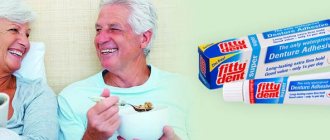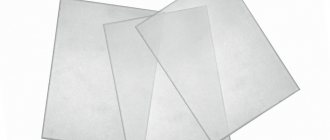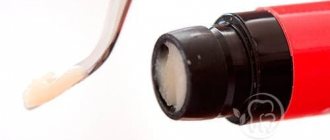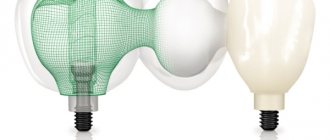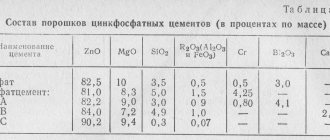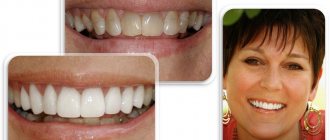- general information
- Compound
- Advantages of the drug
- Flaws
- Mode of application
- Review of manufacturers
- Price
Almost all patients, having decided on artificial restoration of teeth through prosthetics, know little about the materials used during the operation. Perhaps very few people know that there are a huge number of cement composites, each of which is designed for a particular clinical case. What is glass ionomer cement, what are its features and advantages, manufacturing specifics and varieties - this material is dedicated to this.
General information about glass ionomer cement
Glass ionomer cements (hereinafter referred to as GIC) are the latest innovative mixtures characterized by a heterogeneous structural content, where the base part is aluminosilicate glass, and polyacrylic acids act as a polymer matrix.
GIC is the optimal solution for placing fillings on a temporary basis, as well as being used as insulating liners.
Initially liquid in consistency, the mass gradually hardens and takes on the desired state. This happens in several stages:
- dissolution – the process of formation of ions;
- gelation – creation of gel-polymer chains, increase in pH level. The duration of the transition to this state is about 5 minutes;
- complete hardening of the material occurs within 24 hours.
The mixture reacts well with hard tooth tissues, intensely releasing fluoride elements. It is characterized by an average degree of strength, interacts better with enamel than with dentin tissue, and has an inhibitory effect on previously formed caries manifestations.
Stages
After preparing the surface, the orthopedist makes an impression of the jaws, from which a crown is stamped or cast in the laboratory. Manufacturing takes several days. Before installing the structure, they carry out fittings - check how it fits and whether there are any defects. The crown may be too wide, narrow, or high. Fitting helps to notice shortcomings and eliminate them.
The restoration is first placed with temporary cement. The patient is given the opportunity to get used to a foreign object in the mouth, to understand whether the height is disturbing or whether the edge is cutting the gum. Only after this the structure is installed on permanent cement.
- Before fixation, the crown is treated with a special solution, degreased and dried.
- Next, the tooth is treated with an antiseptic, and the remaining moisture is removed with ether or air. In some cases, gum retraction is performed with a thread to clearly mark the junction of the artificial crown and hard tissue.
- The components for cement are mixed on a sterile plate.
- A thin layer of cement is placed inside the restoration and placed over the tooth.
- Excess is removed. The patient is asked to sit with his teeth closed. Then clean the surfaces again and rinse your mouth with a special solution. This completes the orthopedist’s work.
Composition of glass ionomer cement
The filling component consists of standard elements for such materials - distilled water and powder mass. As a result of their interaction, they become solid from a liquid state - this is ensured by the influence of acidic processes.
Most often, alkene polymers are used to create GIC:
- maleic;
- polyacrylic;
- itaconic.
They help reduce the viscosity of cement, slow down the process of gelation of the liquid and bind all the elements into a homogeneous mass several times faster. These qualities have a positive effect on the service life of the composition.
The liquid part basically contains distillers or tartaric acid. Powder – calcium silicate glass and calcium fluoride drops.
Upon completion of the filling processes, fluoride ions begin to be actively released into the oral cavity, which is an excellent obstacle to the development of secondary caries manifestations. The silicate substance is necessary for proper acid reactions to occur. Mineral substances in contact with glass form a silicon film, which is subsequently impregnated with acidic masses. In this case, the processing time becomes shorter, and the hardening time, on the contrary, becomes longer. The same principle is used to ensure hygroscopic reduction.
Causes of crown loss
Several factors can provoke an unpleasant situation associated with dental crowns. They depend both on the actions of the doctor and on the actions of the patient.
- Low quality materials and cement.
- Violation of the manufacturing technique of an orthopedic structure.
- Mistakes at the stage of preparation for prosthetics.
- Development of the inflammatory process under the crown.
- End of service life of the structure.
- Mechanical injury.
The permanent crown is fixed with dental cement and lasts for several years. If the doctor did everything correctly at the preparation stage, then the structure retains its tightness and strength for a long time, and it should not fall out. This can happen due to the development of caries, which appears due to irregular or improper oral hygiene. Therefore, it is so important not to skip brushing your teeth and use additional hygiene products. And also undergo professional oral hygiene at a dental clinic once every six months.
Advantages of glass ionomer cement
Glass ionomers have the following advantages, in comparison with analogue filling materials:
- ease of use - cement fills the cavity in one or two portions. Its use does not involve the processes of preliminary etching of the area and bonding of dentin;
- the unique property of hardening even in a humid environment - this quality ensures the active use of the composition in the treatment of caries cavities in the cervical zone, elimination of wedge-shaped pathologies, as well as caries, the affected area is the area located below the gum level;
- connection of the component with the tissues of dentin and enamel according to the intermolecular principle - makes it possible to install fillings with excellent marginal fit and eliminates the need to create retention areas during the treatment of the organ;
- complete adhesion to compositions with clove oil - thus, GIC is used as insulating liners that protect fabrics from excessive attachment of composites to them;
- adhesion to metal components;
- the ability to release ion enzymes into the organ cavity for at least a year after the filling is installed;
- weak shrinkage during polymerization - at the moment of transformation into a solid state, cement slightly increases in volume, which partially compensates for shrinkage processes;
- no irritating effect on dentin and pulp tissue - their composition is not aggressive and not dangerous in the treatment of deep caries if cement is used as a spacer;
- the thermal expansion indicator corresponds to the coefficient of expansion of the organ tissue - in such a situation, the filling is fixed more reliably, lasts longer, and its marginal fit is an order of magnitude better. This is a good preventive protection against the formation of damage to the enamel surface - cracks, chips.
Prosthetics on implants
Crowns are secured to implants in 2 ways: with cement or a screw
. This depends, first of all, on the type of implantation and the implant models that are used. But anatomical features and clinical manifestations play a big role.
Cement fixation of crowns on implants has its pros and cons. The process of attaching a restoration to an implant using cement is not much different from prosthetics on natural teeth. It is simple, well studied, and allows fixation in complex cases where a screw fixation would require enormous effort and skill.
The disadvantages include the possibility of peri-implantitis, which can be caused by excess cement. When using cement, the crown cannot be repaired, only replaced.
Screw fixation of crowns to the implant prevents cement from getting on the tissue. There is a possibility of repair and correction. The results of joining metal to metal without a cement layer are better. The single design of abutment and crown reduces the risk of infection.
However, the fitting of a screw-fixed prosthesis is more delicate, requires certain skills, and the price of designs with screws is higher.
This is why choosing a doctor is so important. A qualified implantologist takes into account dozens of details before choosing an implantation method, which determines whether the crown will be screw-fixed or cemented, and an experienced orthopedist knows how to work with both.
Disadvantages of glass ionomer cement
The material is not without its shortcomings, some of which are quite significant:
- long maturation of the cement composition - it completely hardens only a day after installation, despite the fact that the first setting occurs within a few minutes;
- in the first hours the mixture is sensitive to a humid environment - it is at that stage that active leaching of ions occurs, which slows down the processes of final polymerization;
- poor resistance of the structural content to mechanical vibration - the material cannot be affected by a conventional drill immediately after installing the filling;
- etching of organ tissue is unacceptable;
- limited use for complex caries with a deep damaging effect;
- poor resistance to diametric tension, which completely excludes the use of GIC for the treatment of occlusal surfaces, as well as in clinical situations when the load on the tooth is distributed in different directions;
- shorter service life compared to conventional cement composite;
- average level of aesthetics, which limits its use on the frontal areas of the jaw row.
General overview
The structure of glass ionomer cement is a combination of a thermoplastic polyacrylic polymer and a silicate system. The practice of using the composition confirms the functionality of the new material, which is significantly superior to standard adhesive compositions based on phosphate and polycarbonate with the addition of zinc. Within the framework of the accepted classification, three main criteria are used to differentiate existing types of GIC:
- Based on the purpose of use, materials are selected for securing dentures and orthodontic correctors, strengthening the structure of teeth, fixing aesthetic fillings and onlays, as well as ensuring a tight fit of restoration elements;
- From the point of view of the release form, powder, capsule and paste cement is divided, supplied in ready-to-use form;
- Based on the mechanics of polymerization, a distinction is made between compositions that harden under the influence of light, as well as as a result of chemical interaction with water.
The choice of material for prosthetics is determined by the indications of the clinical picture formed based on the results of preliminary diagnostics.
Method of using glass ionomer cement
The algorithm for using standard glass ionomer cements is as follows:
- thorough treatment of the working area with a conditioning liquid, which is washed off 20 seconds after application and the cavity is well dried;
- the damaged tooth is isolated from moisture and salivary secretions for the entire period of setting of the mass - about 5 - 6 minutes;
- the liquid and powder composition are mixed until a shiny, homogeneous thick mass is obtained;
- they place it in the organ cavity and form a filling, while ensuring dense condensation using a cotton swab or a special device with a spherical movable working tip;
- after giving the filling the desired shape, its relief is coated with varnish;
- after 1 – 2 days, treat with a drill. After this, the tooth can function normally.
Zinc phosphate dental cement for fixation of crowns and dentures
It is the oldest of the dental cement compositions that dentists now practice.
Mix immediately, right before use. It contains 65-70% powder, represented by magnesium or zinc oxides, and the liquid part is an aqueous solution of phosphoric acid.
Application
- Installation of single crowns and bridges on 3-4 teeth in patients without hypersensitivity.
- Fixation of pin structures on a well-preserved root protruding above the gum.
- Prosthetic bridges for more than 4 teeth.
Zinc phosphates are characterized by:
- Easy to use.
- Medium strength and adhesiveness.
- Increased tooth sensitivity for 1 day - 3 weeks.
- Rarely cause allergies.
BY THE WAY : The peculiarity of this type of cement is that it can harden quickly, and therefore the doctor must quickly deal with it.
Overview of glass ionomer cement manufacturers
Despite the fact that the composition of the GICs of the main manufacturers is almost identical, the following line of leading manufacturers are distinguished in the domestic market of dental materials, firmly holding the rating for a long period of time. It is advisable to consider the features in more detail.
Arde Kwik Tsem
It is a fluid hybrid mixture of a double solidification principle. Ideal for attaching veneers, bridge devices, and inserting pins during restoration with implants.
Thanks to its unique structural content and viscous consistency, it ensures the highest quality filling of the tooth cavity.
It has a serious disadvantage - it can provoke individual intolerance and cause allergic reactions of varying degrees of intensity.
Arde Fix
It is used for permanent fixation of orthodontic and prosthetic devices. Not prone to dissolution and oxidation in the oral cavity. If the composition is mixed correctly, side effects and complications are completely excluded. May cause a short-term decrease in the sensitivity of taste buds, which resolves spontaneously after some time. It does not tolerate the presence of eugenol elements in the work area.
Fuji Plus
A distinctive feature of the mixture is its modification with a composite, which provides a number of advantages:
- stronger fixation;
- possibility of use when interacting with metal, non-metal, ceramic prosthetic structures of all types in the process of orthopedic manipulations.
The disadvantage is the weaker light reflectivity of the material in the solid state.
Ketak Tsem
The main advantage is simplicity and ease of use. Shorter time for manual mixing and bringing to the required consistency.
It has high aesthetic indicators - a matte, slightly silky surface, which is especially important when working on the frontal area of the jaw.
The disadvantage is sensitivity to low temperatures, which increase the hardening time.
Tsemion F
The composition has good radiopacity, withstands high mechanical loads in comparison with analogue products, and has a low solubility index.
Adhesive to enamel and dentin tissues.
Allows you to achieve a high level of marginal sealing, releases fluoride over a longer period of time, which helps strengthen tooth enamel. It has a low pain sensitivity threshold and causes virtually no discomfort in patients during the rehabilitation period after treatment.
Glass ionomer cement price
Depending on the manufacturer, the cost of cement of various brands looks something like this:
Arde Kwik Cem - from 1,300 rub.
Arde Fix - from 1,420 rub.
Fuji Plus - from 1,520 rub.
Ketak Tsem - from 1,380 rub.
Tsemion F - from 1,240 rub.
Having placed a filling from the material discussed in this article, you don’t have to worry that after a short time it will crumble under temperature or mechanical influence. And although in some respects cement is inferior to more expensive mixtures, with proper use the tooth will retain its functionality for a fairly long period of time.
Prevention of crown loss
Once you have a crown installed, we recommend making sure it lasts a long time. To do this, you need to remember and follow simple rules.
- Forget about sticky candies, chewing gum, the habit of biting your nails, the tip of a pencil or pen.
- Brush your teeth regularly. If you haven't used brushes or an irrigator yet, now is the time. Also, don't forget about mouthwash.
- Monitor the condition of the crown. If even small defects are detected, it is recommended to consult a doctor.
- Once every six months, come for a check-up with an orthopedic dentist and do professional oral hygiene.
The loss of a crown causes great inconvenience. If this happens, you should immediately contact your dentist.



